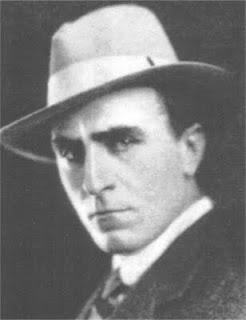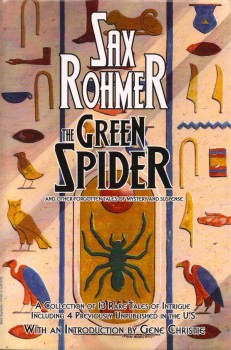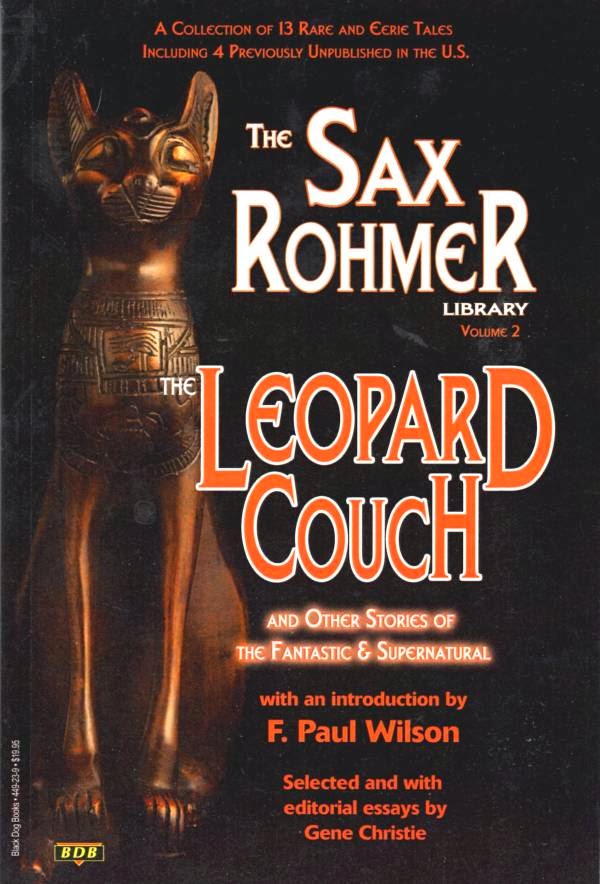Blogging Sax Rohmer… In the Beginning, Part Three

 “The M’Villin” was first published in Pearson’s Magazine in December 1906. Rohmer was still writing stories under the modified version of his real name, A. Sarsfield Ward. The story represented a quantum leap forward in the quality of Rohmer’s fiction and shows the influence of Alexandre Dumas’s swashbucklers.
“The M’Villin” was first published in Pearson’s Magazine in December 1906. Rohmer was still writing stories under the modified version of his real name, A. Sarsfield Ward. The story represented a quantum leap forward in the quality of Rohmer’s fiction and shows the influence of Alexandre Dumas’s swashbucklers.
Dumas remained a surprising influence on the author who still turned out the odd swashbuckler as late as the 1950s. It should also be noted that the character of Lola Dumas in President Fu Manchu (1936) is said to be a descendant of the famous author, while The Crime Magnet stories Rohmer penned in the 1930s and 1940s feature Major de Treville, a character whose surname suggests he is a descendant of the commander of the Musketeers from Dumas’s D’artagnan Romances.
Colonel Fergus M’Villin may be oddly named, but he makes for a fascinating character. An expert swordsman and fencing master, he is also a bit of a cad. The story of how he comes to avenge the honor of the man he previously slew in an earlier duel maintains the breezy good humor and spirit of adventure that colors The Three Musketeers in its earlier chapters. Rohmer thought well enough of the character to have penned a sequel, “The Ebony Casket,” but it was never published. The manuscript survived up until the year 2000, when it was junked in Tokyo by a family who did not imagine its worth to collectors.
Rohmer remained proud of the story and included it in his 1932 collection of short fiction, Tales of East and West. He slightly altered the spelling of the character’s name and the story’s title to “The McVillin.” It only appears in the rare UK edition published by Cassell and not the US edition by Doubleday or its reprint by Bookfinger. The story would not be reprinted until Gene Christie collected it for the first volume of Black Dog Books’ Sax Rohmer Library, The Green Spider and Other Forgotten Tales of Mystery and Suspense in 2011.

 In spite of the story’s quality, Rohmer took a break from writing fiction (perhaps disheartened by his failure to sell a second M’Villin story). He concentrated on writing songs and comedy sketches for music hall performers. Surprisingly, he found a degree of success in this respect. It was with his music hall efforts that he first started using the Sax Rohmer pseudonym.
In spite of the story’s quality, Rohmer took a break from writing fiction (perhaps disheartened by his failure to sell a second M’Villin story). He concentrated on writing songs and comedy sketches for music hall performers. Surprisingly, he found a degree of success in this respect. It was with his music hall efforts that he first started using the Sax Rohmer pseudonym.
He married Rose Elizabeth Knox during this period. She came from a music hall family with her brother Teddy, achieving the most fame as a member of The Crazy Gang. A hugely popular comedy troupe in their day, The Crazy Gang influenced The Goon Show (Goons Spike Milligan and Peter Sellers regularly lampooned Sax Rohmer’s Yellow Peril thrillers) and Monty Python. A direct line between Rohmer and the anarchic comedy that came to typify British humor in the twentieth century was firmly established by the unexpected pairing of these two music hall veterans.
“The Death of Cyrus Pettigrew” marked Rohmer’s return to fiction. The story was first published in The London Magazine in March 1909 and was once again credited to A. Sarsfield Ward. He returned to an earlier story, “The Mystery of the Marsh Hole” in naming his hero, the amateur detective Dr. Saxham. This was Rohmer’s most successful attempt yet to model his fiction after Sir Arthur Conan Doyle’s Sherlock Holmes stories. Dr. Saxham and his narrator/companion Barton (another recycled name and one that Rohmer borrowed from his own life since he counted one Lionel Barton among his closest friends at the time) set out to investigate the poisoning of Cyrus Pettigrew on the evening train back home.
Rohmer provides an interesting twist in having the damsel-in-distress, Pettigrew’s seemingly virtuous niece, revealed as a morphine addict who becomes Scotland Yard’s primary suspect in the case. Foreshadowing the Fu Manchu stories to come, Rohmer offers murder by the bite of an exotic Burmese spider achieved by credibility-straining means of being suspended from a fishing line from the window of a passing train. Longtime readers will not be the least bit surprised to learn the real murderer is a half-caste German-Indian who, in true Rohmer fashion, opts for suicide when confronted with his guilt.
This well-written tale was rescued from obscurity by Jack Adrian, who included it in the anthology, The Art of the Impossible, published by Xanadu Publications in 1990. A U.S. edition was published by Carroll & Graf that same year as Murder Impossible: An Extravaganza of Miraculous Murders, Fantastic Felonies, and Incredible Criminals. Like many of Rohmer’s early stories, it most recently appeared in the first volume of Black Dog Books’ Sax Rohmer Library, The Green Spider and Other Forgotten Tales of Mystery and Suspense.
“The Sedgley Abbey Tragedies” was published the following month in The London Magazine in April 1909. This time around, the author was mistakenly credited as J. Sarsfield Ward, after which an irritated Rohmer dispensed with the Sarsfield Ward byline. While still actively using the Sax Rohmer pseudonym for his songwriting and comedy sketches, he would choose to author his next several pieces of fiction anonymously.
The name Sedgley was likewise salvaged from “The Mystery of the Marsh Hole.” The narrator this time around is an artist called Stuart who is visiting the village of Sedgley to capture its natural beauty on his canvas. He inadvertently becomes embroiled in a series of murders, at the site of a disused abbey, committed by an escaped mental patient. The interesting feature here is that Stuart is no amateur detective. He merely documents Scotland Yard’s successful investigation of the murders and the clever means by which they force the killer out into the open.
Another strong piece of writing, Rohmer fans are once again indebted to Gene Christie and Black Dog Books for rescuing the story from obscurity for the first volume of their Sax Rohmer Library, The Green Spider and Other Forgotten Tales of Mystery and Suspense in 2011. In our next installment, we will examine Rohmer’s anonymously published literary efforts, including his first two book-length efforts.
William Patrick Maynard was authorized to continue Sax Rohmer’s Fu Manchu thrillers beginning with The Terror of Fu Manchu (2009; Black Coat Press) and The Destiny of Fu Manchu (2012; Black Coat Press). The Triumph of Fu Manchu is coming soon from Black Coat Press.